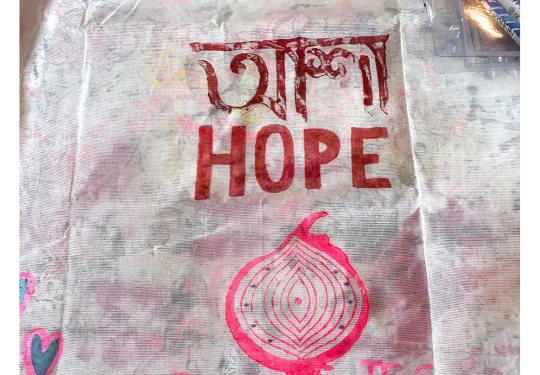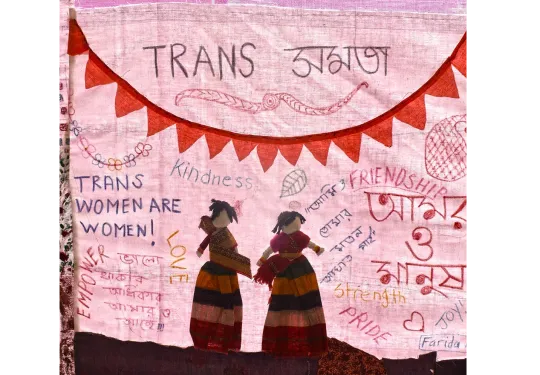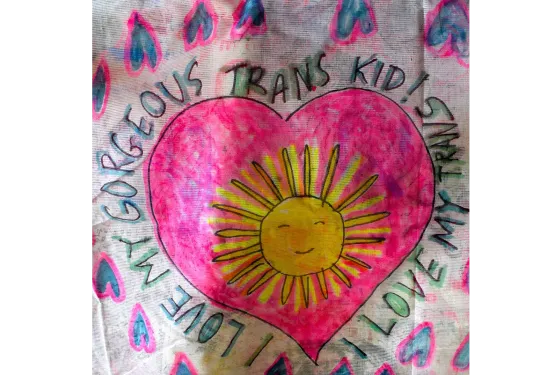More Than a Friend ... an Ally
By:
John Abdullah
On
02/06/2025Reading time:
12 min
Summary:
I decided to support WorldPride when it came to my hometown of Washington, DC after my friend Joe (@jsirakasphotos) sent me the link. We’ve done photography together for years and are practically family, so the chance to support something I also believe is critically important was an easy yes. That’s how this journey began, but it was through working on the powerful Storytelling with Saris project that the personal reason I needed to be part of this truly hit home.
As a volunteer photographer, I’ve had the opportunity to witness events that are educational, beautiful, fun - and sometimes deeply moving. On this particular Saturday, I headed to Gallery Place to document a powerful project that was part of the World Pride parade. The initiative, Storytelling with Saris, is led by the talented and inspiring Monica Jahan Bose (monicajahanbose.com, IG @storywithsari).
Monica, a Bangladeshi-American artist and climate activist whose work spans painting, printmaking, performance, film, and interdisciplinary collaborations, created this initiative (storytellingwithsaris.com) in partnership with her ancestral village of Katakhali, Bangladesh. A sari is a traditional South Asian garment made from a long piece of cloth. In Bangladeshi heritage, it represents cultural pride, feminine strength, and centuries of artisanal craftsmanship.
For Pride, Monica launched a project to create five saris, each infused with art and messages supporting the goals of the Pride movement. The plan was to stitch all five together into one 100 foot long piece, and carry it in a powerful visual statement through the heart of the capital during the main Pride march.
As the sari was being created, several people had gathered to support the effort. Monica invited everyone to contribute - through painting, woodblock printing, and by adding a six-word poem to the fabric.
I was photographing this event along with two others happening in the same space, so I was locked into my usual mindset: capturing technically sound images while also trying to convey the artistic message and story behind them.
Then Monica asked me if I’d like to write one of the poems. As I was mentally listing reasons to decline, she handed me a marker (so clearly, the right answer was yes). Poetry isn’t my natural gift, but I figured six words couldn’t be that hard. As a cis het man, I wanted to reflect on what drew me to support this effort in the first place. The six words came to me quickly - and when they did, they hit hard:
“More than a friend — an ally.”
That was exactly what I’d been feeling when I stepped into this project. And in that moment, it brought back some painful memories of why simply being a friend isn’t always enough.
Why "Friend" isn't Enough
Growing up in the Deep South in the ’70s, I had a more diverse set of friends than you might imagine. One of my friends - someone I’d known since third grade - was someone I thought of as a good friend. As immature boys tend to do, we mercilessly kidded each other as a sign of (and they don’t make apostrophes strong enough for this) “manhood.”
Being Middle Eastern, the go-to jabs aimed at me were about the size of my nose or some ignorant heritage-related taunt. But my friend I’d known since third grade had an effeminate voice (far more cruel words were used back then), and he was teased even more relentlessly than I was.
There was a different tenor to the taunts aimed at him; the disdain was palpable. As his friend, I’d sometimes say, “Aren’t you being an ass about this? C’mon, back off,” and occasionally that would work... but not for long.
See, I was his friend and that’s what friends do.
He wasn’t out in any way. No one at our high school would have dared. The threats and potential for violence were real. Not just for him, but for any of his friends with the courage to truly stand up for him.

Monica showing an earlier made Sari

From the mural being made
Reality Crashes In
He went to a rival college after high school, and I hadn’t seen him since. About ten years after college, I caught up with a mutual friend, someone I’d also been close with. As we talked, we started figuring out where everyone had ended up, and I asked about our friend. He paused and said, “Did you know he came out in college?”
I replied with something like, “Well, I guess he didn’t feel safe doing it back at our redneck high school.” Another, even longer pause.
“He recently died of AIDS.”
My heart sank. All I could think was: what kind of friend was I, if someone I’d considered a close friend since we were little kids couldn’t share something so fundamental with me - because of fear? We both sat in silence for a while. I knew I needed to be a different person about this. What exactly that meant would take time to figure out.
My college, surprisingly, was more open-minded than you’d expect for where it was. LGBTQ+ life was more visible and accepted. I had friends, including frat brothers, who were openly LGBTQ+, and it wasn’t a big deal to me.
You see, a safe space for them was also a safe space for us to be real friends. The outside world... not so much.
Beginnings of Being an Ally
Going forward, I’d love to say I instantly became a super-ally — though that word wasn’t commonly used yet for the level of support we’re talking about — but I did want to do something. That first meant being firm in opposing the suppression of people, regardless of their identity. I tried to be clear and proactive, and as a fairly new dad, I knew that had to start at home.
As someone active in my church, it also meant making sure that our love for all neighbors drowned out the voices who treated that as a suggestion, rather than the core of our faith. I felt like I was doing all the right things, and I worked on myself not to become complacent.
But did it make a difference?

More art from the Sari

From the Sari a reminder to treat people with respect for who they are
Glimmer of Hope
About ten years ago, I was sitting in my church, hanging around after the service, when I saw someone I had known from my Sunday School class. We hadn’t chatted in a couple of years, between my divorce and him seemingly MIA. We greeted each other with a smile and the usual church hug/handshake. Then, after the service, he sat down next to me with a more serious look on his face.
After a pause, he came out to me, right then and there. At that point, he had only told the choir director, since he had a passion for singing and had previously been in the choir. His struggle was whether, now that he was out, he could still be up front in the church.
After a quick internal flashback to my friend from third grade, we had a real and open discussion about why he should absolutely worship in music if that’s where he felt led. At the time, the choir director and I were the only ones who knew, and we both told him: sing, if that’s what your heart says.
When I saw him up there a couple of weeks later, I knew we were both closer to the divine. For me, it was a moment of understanding that the “love” in love your neighbor is an action verb, not a generic concept.
Where do we go from Here?
If the above sounded like a victory lap or a plea for a pat on the back, it's far from that. It did make me realize, though, that to make a difference in the lives of people who are being downtrodden and suppressed, you need to both understand them and be someone they can trust. Being an ally implies an active role - that you’re working together for a common cause. To work together, you need to know where they are, where we all should end up, and ensure a level of trust remains so that the alliance is strong and successful.
That was on my mind when I agreed to support Pride this year. Many thanks to Monica for making that crystal clear. I have a Shepard Fairey poster that says, Art Heals. Monica said she was amazed at how many people found the creation of the sari to be a healing process. Whether through art, service, protest, or however you feel led, may you be an ally for healing - for those who need it, for yourself, and for our land.

Love the beauty in everyone wherever they or you are at
